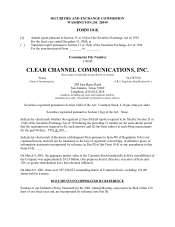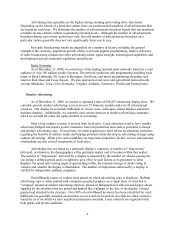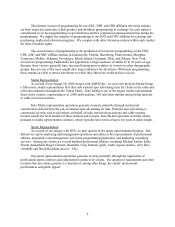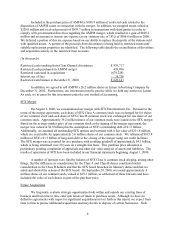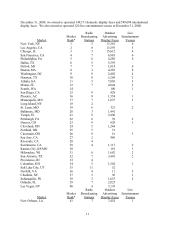iHeartMedia 2000 Annual Report Download - page 5
Download and view the complete annual report
Please find page 5 of the 2000 iHeartMedia annual report below. You can navigate through the pages in the report by either clicking on the pages listed below, or by using the keyword search tool below to find specific information within the annual report.
5
Wallscapes are essentially billboards painted on vinyl surfaces or directly on the sides of
buildings, typically four stories or less. Because of their greater impact and higher cost, larger billboards
are usually located on major highways and freeways. Some of our billboards are illuminated, and located
at busy traffic interchanges to offer maximum visual impact to vehicular audiences. Wallscapes are
located on major freeways, commuter and tourist routes and in downtown business districts. Smaller
billboards are concentrated on city streets targeting pedestrian traffic.
Transit advertising incorporates all advertising on or in transit systems, including the interiors and
exteriors of buses, trains, trams and taxis, and advertising at rail stations and airports. Transit advertising
posters range from vinyl sheets, whic h are applied directly to transit vehicles, to billboards and panels
mounted in station or airport locations. Transit advertising contracts are negotiated with public transit
authorities and private transit operators, either on a fixed revenue guarantee or a revenue-share basis.
Street furniture panels are developed and marketed under our global Adshel brand. Street
furniture panels include bus shelters, free standing units, pillars and columns. The most numerous are
bus shelters which are back illuminated and reach vehicular and pedestrian audiences. Street furniture is
growing in popularity with local authorities. Bus shelters are usually constructed, owned and maintained
by the outdoor service provider under revenue-sharing arrangements with a municipality or transit
authority. Street furniture contracts are usually won in a competitive tender and last between 10 and 15
years. Tenders are won on the basis of revenues and community-related products offered to
municipalities, including bus shelters, public toilets and information kiosks.
Live Entertainment
We significantly expanded our presence in the live entertainment industry with our August 2000
acquisition of SFX Entertainment, Inc. We are one of the world’ s largest producers, promoters and
marketers of live entertainment. Last year, more than 60 million people attended approximately 26,000 of
our events, including: live music events; Broadway and touring Broadway shows; family entertainment
shows; and specialized sports and motor sports events. As of December 31, 2000, we owned or operated
a total of 92 domestic venues and 28 international venues. We also produce touring and original
Broadway shows and derive revenues from our theater operations. Additionally, we currently own
various interests in live entertainment companies, which we account for under the equity method of
accounting.
We derive revenues from our venue operations primarily from ticket sales, rental income,
corporate sponsorships and advertising, concessions, and merchandise. A venue operator typically
receives for each event it hosts a fixed fee or percentage of ticket sales for use of the venue, as well as
fees representing a percentage of total concession sales from the vendors and total merchandise sales from
the performer or tour producer. We typically receive 100% of sponsorship and advertising revenues and a
rebate of a portion of ticketing surcharges.
Other
Television
As of December 31, 2000, we owned, programmed or sold airtime for 19 television stations. Our
television stations are affiliated with various television networks, including FOX, UPN, ABC, NBC and
CBS. Television revenue is generated primarily from the sale of local and national advertising, as well as
from fees received from the affiliate television networks. Advertising rates depend primarily on the
quantitative and qualitative characteristics of the audience we can deliver to the advertiser. Local
advertising is sold by our sales personnel, while national advertising is sold by national sales
representatives.

